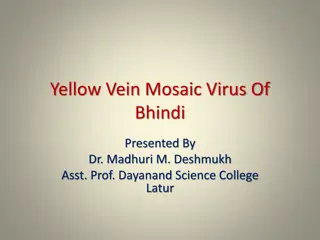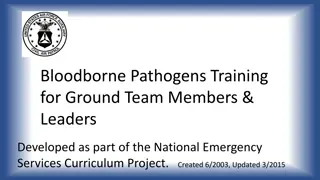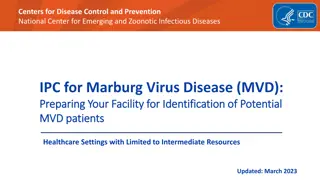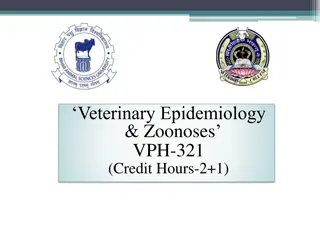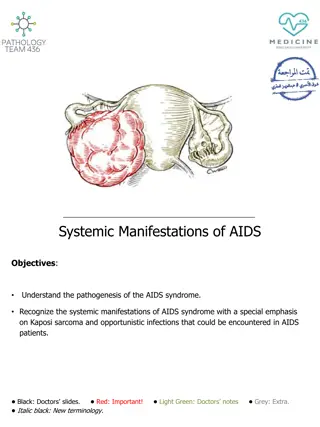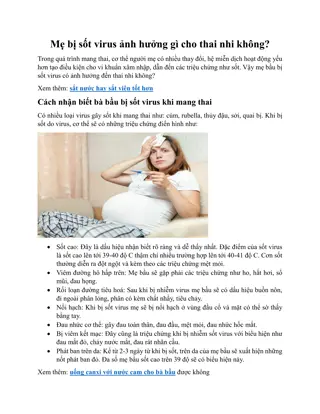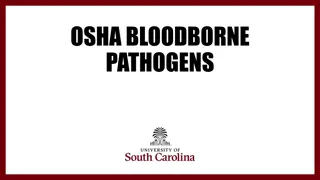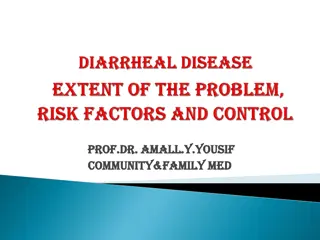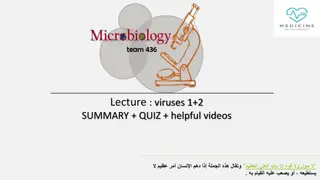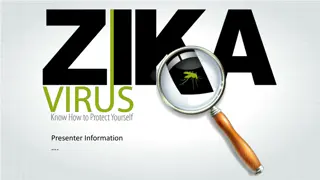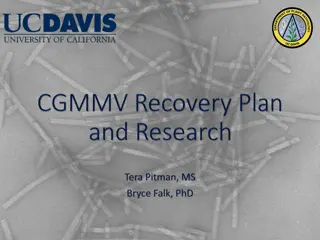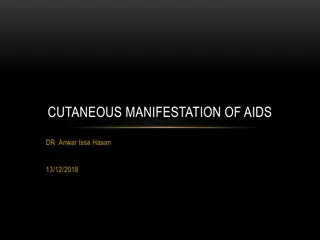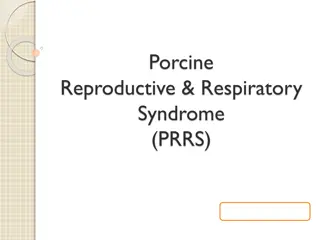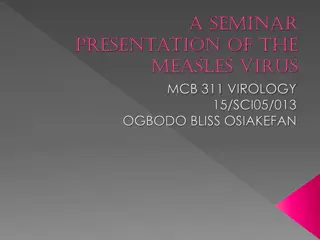Human Immunodeficiency Virus
HIV, a member of the lentivirus subfamily of retroviruses, causes Acquired Immunodeficiency Syndrome (AIDS). HIV-1 and HIV-2 have distinct characteristics, with HIV-1 being global and HIV-2 primarily in West Africa. The virus encodes reverse transcriptase and has an envelope containing glycoproteins. Its genome consists of positive-polarity RNA. Key viral genes and enzymes are involved in integration and replication within host cells. Important antigens like gp120 and p24 play crucial roles in viral infectivity and immune response.
Download Presentation

Please find below an Image/Link to download the presentation.
The content on the website is provided AS IS for your information and personal use only. It may not be sold, licensed, or shared on other websites without obtaining consent from the author.If you encounter any issues during the download, it is possible that the publisher has removed the file from their server.
You are allowed to download the files provided on this website for personal or commercial use, subject to the condition that they are used lawfully. All files are the property of their respective owners.
The content on the website is provided AS IS for your information and personal use only. It may not be sold, licensed, or shared on other websites without obtaining consent from the author.
E N D
Presentation Transcript
Human Immunodeficiency Virus Acquired Immunodeficiency syndrome first described in 1981 HIV-1 isolated in 1984, and HIV-2 in 1986 Belong to the lentivirus subfamily of the retroviridae Encode reverse transcriptase enzyme which makes a double stranded DNA from the single-stranded RNA genome Enveloped RNA virus, 120nm in diameter HIV-2 shares 40% nucleotide homology with HIV-1 Viral genes permanently integrated into host DNA HIV can only infect host cells that have the required CD4 marker, mainly helper (CD4) T lymphocytes Both HIV-1 and HIV-2 cause AIDS, but HIV-1 is found worldwide, whereas HIV-2 is found primarily in West Africa.
HIV belongs to the lentivirus subgroup of retroviruses, which cause "slow" infections with long incubation periods. HIV has a bar-shaped (type D) core surrounded by an envelope containing virus- specific glycoproteins (gp120 and gp41). The genome of HIV consists of two identical molecules of single-stranded, positive-polarity RNA and is said to be diploid
Insert figure 25.13 HIV general structure 4
HIV Genome and Structure The HIV genome has three main gag gene pol gene env gene genes env proteins Viral envelope proteins gag proteins Capsid Matrix pol proteins Viral enzymes
Three enzymes are located within the nucleocapsid of the virion: reverse transcriptase, integrase, and protease. The pol gene encodes several proteins, including the virion "reverse transcriptase," which synthesizes DNA by using the genome RNA as a template, an integrase that integrates the viral DNA into the cellular DNA, and a protease that cleaves the various viral precursor proteins.
There are several important antigens of HIV: gp120 and gp41 are the type-specific envelope glycoproteins. gp120 protrudes from the surface and interacts with the CD4 receptor on the cell surface. gp41 is embedded in the envelope and mediates the fusion of the viral envelope with the cell membrane at the time of infection. Antibody against gp120 neutralizes the infectivity of HIV, but the rapid appearance of gp120 variants will make production of an effective vaccine difficult. The group-specific antigen, p24, is located in the core and is not known to vary. Antibodies against p24 do not neutralize HIV infectivity but serve as important serologic markers of infection.
The reproductive cycle of HIV illustrates the pattern of infection and replication in a retrovirus. After HIV enters the host cell, reverse transcriptase synthesizes double stranded DNA from the viral RNA. Viral mRNA is transcribed from the proviral DNA by host cell RNA polymerase and translated into several large polyproteins The immature virion containing the precursor polyproteins forms in the cytoplasm, and cleavage by the viral protease occurs as the immature virion buds from the cell membrane. It is this cleavage process that results in the mature, infectious virion
Transmission of HIV occurs primarily by sexual contact and by transfer of infected blood. Perinatal transmission from infected mother to neonate also occurs, either across the placenta, at birth, or via breast milk. Transmission of HIV via blood transfusion has been greatly reduced by screening donated blood for the presence of antibody to HIV. However, there is a "window" period early in infection when the blood of an infected person can contain HIV but antibodies are not detectable. Blood banks now test for the presence of p24 antigen in an effort to detect blood that contains HIV. 14
Colored scanning electron micrograph of a T4 cell (green) producing HIV (red).
Pathogenesis and Virulence Factors of HIV HIV enters through mucous membrane or skin and travels to dendritic phagocytes beneath the epithelium, multiplies and is shed. after which the local CD4-positive helper T cells become infected. HIV is first found in the blood 4 to 11 days after infection. Reverse transcriptase makes a DNA copy of RNA. Viral DNA is integrated into host chromosome (provirus). Can produce a lytic infection or remain latent HIV infects helper T cells (CD4-positive cells) and kills them, resulting in suppression of cell-mediated immunity. This predisposes the host to various opportunistic infections and certain cancers such as Kaposi's sarcoma and lymphoma 16
Insert figure 25.14 HIV routes of infection 17
Signs and Symptoms of HIV Infections and AIDS The clinical picture of HIV infection can be divided into three stages: an early, acute stage; middle, latent stage; and a late, immunodeficiency stage 1. In the acute stage, which usually begins 2 to 4 weeks after infection, a mononucleosis-like picture of fever, lethargy, sore throat. This acute stage typically resolves spontaneously in about 2 weeks 2.In the middle stage, a long latent period, measured in years, usually ensues. In untreated patients, the latent period usually lasts for 7 to 11 years. The patient is asymptomatic during this period. 3.The late stage of HIV infection is AIDS, manifested by a decline in the number of CD4 cells to below 400/ L and an increase in the frequency and severity of opportunistic infections 18
typical primary HIV-1 infection symptoms symptoms HIV proviral DNA HIV antibodies window period HIV viral load HIV-1 p24 antigen 0 1 2 3 4 5 6 / 2 4 6 8 10 1 infection weeks years Time following infection
Table 2 Common Opportunistic Infections in AIDS Patients Site of Infection Lung Mouth Esophagus Intestinal tract Disease or Symptom 1. Pneumonia 2. Tuberculosis 1. Thrush 2. Hairy leukoplakia 3. Ulcerations 1. Thrush 2. Esophagitis Diarrhea Causative Organism Pneumocystis carinii, cytomegalovirus Mycobacterium tuberculosis Candida albicans Epstein-Barr virus Herpes simplex virus-1, Histoplasma capsulatum Candida albicans Cytomegalovirus, herpes simplex virus-1 Salmonella sp., Shigella sp, cytomegalovirus, Cryptosporidium parvum, Giardia lamblia Cryptococcus neoformans Central nervous system 1. Meningitis 2. Brain abscess 3. Progressive multifocal leukoencephalopathy Retinitis 1. Kaposi's sarcoma 2. Zoster 3. Subcutaneous nodules Lymphadenopathy or splenomegaly Toxoplasma gondii JC virus Eye Skin Reticuloendothelial system Cytomegalovirus Human herpesvirus 8 Varicella-zoster virus Cryptococcus neoformans Mycobacterium avium complex, Epstein-Barr virus 20
Diagnosis of HIV Infection Testing based on detection of antibodies specific to the virus in serum or other fluids; done at 2 levels Initial screening ELISA, latex agglutination and rapid antibody tests rapid results but may result in false positives Follow up with Western blot analysis to rule out false positives. False negatives can also occur; persons who may have been exposed should be tested a second time 3-6 months later. The polymerase chain reaction (PCR) is a very sensitive and specific technique that can be used to detect HIV DNA within infected cells. Some individuals who do not have detectable antibodies have been shown by this test to be infected 21
ELISA for HIV antibody Microplate ELISA for HIV antibody: coloured wells indicate reactivity
Western blot for HIV antibody There are different criteria for the interpretation of HIV Western blot results The most important antibodies are those against the envelope glycoproteins gp120, gp160, and gp41 p24 antibody is usually present but may be absent in the later stages of HIV infection
The Window Period The window period is the period of time between initial infection with HIV and when the body produces detectable antibodies, which can vary from 2 to 12 weeks. During the window period a person is infectious, with a high viral load and a negative HIV antibody test. This means the infected person might get a negative result while actually having HIV.
Preventing and Treating HIV No cure; therapies slow down the progress of the disease or diminish the symptoms In general, initial antiretroviral therapy consists of one of two regimens, each one of which consists of three drugs. One regimen has two nucleoside reverse transcriptase inhibitors (NRTI), such as lamivudine and zidovudine plus a protease inhibitor, such as fosamprenavir. The second regimen has the same two NRTI plus a nonnucleoside reverse transcriptase inhibitors (NNRTI), such as Nevirapine. These combinations are known as HAART 25
Enfuvirtide (Fuzeon) is the first of a new class of anti-HIV drugs known as fusion inhibitors, i.e., they prevent the fusion of the viral envelope with the cell membrane. Enfuvirtide is a synthetic peptide that binds to gp41 on the viral envelope, thereby blocking the entry of HIV into the cell. It must be administered by injection and is quite expensive. 26
Immune reconstitution syndrome" may occur in HIV- infected patients who are treated with a HAART regimen and who are coinfected with other microbes such as hepatitis B virus, hepatitis C virus, Mycobacterium avium complex, Cryptococcus neoformans, and Toxoplasma gondii. In this syndrome, an exacerbation of clinical symptoms occurs because the antiretroviral drugs enhance the ability to mount an inflammatory response. HIV-infected patients with a low CD4 count have a reduced capacity to produce inflammation, but HAART restores the inflammatory response and, as a result, symptoms become more pronounced. To avoid immune reconstitution syndrome, the coinfection should be treated prior to instituting HAART whenever possible.
Prevention No vaccine is available. Prevention consists of taking measures to avoid exposure to the virus, e.g., using condoms, not sharing needles, and discarding donated blood that is contaminated with HIV. Postexposure prophylaxis, such as that given after a needle-stick injury or a high-risk nonoccupational exposure, consists of two drugs, e.g., lamivudine and zidovudine for low-risk exposures and the same two drugs plus lopinavir/ritonavir for high-risk exposures. Two steps can be taken to reduce the number of cases of HIV infection in children: ZDV or nevirapine should be given perinatally to HIV-infected mothers and neonates, and HIV-infected mothers should not breast feed. In addition, the risk of neonatal HIV infection is lower if delivery is accomplished by cesarean section rather than by vaginal delivery. Circumcision reduces HIV infection. Several drugs are commonly taken by patients in the advanced stages of AIDS to prevent certain opportunistic infections. Some examples are trimethoprim-sulfamethoxazole to prevent Pneumocystis pneumonia, fluconazole to prevent recurrences of cryptococcal meningitis, ganciclovir to prevent recurrences of retinitis caused by cytomegalovirus, and oral preparations of antifungal drugs, such as clotrimazole, to prevent thrush caused by Candida albicans.
Vaccines Male and female condoms PEP PrEP Prevention of vertical transmission Microbicides Treatment as prevention Comprehensive HIV prevention ARV Cervical barriers: vaginal diaphragms Male circumcision Clean injecting equipment Voluntary counselling and testing
Why is it difficult to develop a vaccine for HIV and AIDS? There are many reasons for this, including: Nobody has ever recovered from HIV infection, so there is no natural mechanism to imitate HIV destroys the immune system cells that are meant to fight against it Soon after infection, HIV inserts its genetic material into human cells, where it remains hidden from the immune system . HIV occurs in several subtypes, each of which is very different from the others Even within each subtype, HIV is highly variable and constantly changing There are no good animal models to use in experiments although the use of non human primate (NHP) models could become a more significant model for HIV vaccine design and testing in the future. .



